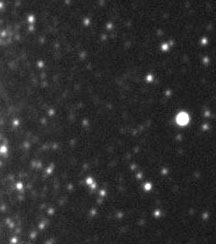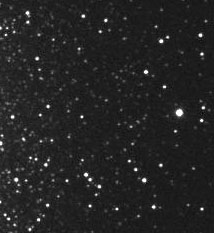Advanced Telescope Supplies
Visual Observing.
Just as motor cars are offered in sports or off-road versions, telescopes can be tailored to suit deep sky, planetary observations or CCD imaging: which is where Advanced Telescope Supplies can advise you on systems that really work! There are brands that we do not sell, but we have a policy of recognising quality brands no matter who handles them. Just knowing the limitations and qualities of a particular instrument is a very good start, because as P.T. Barnum also said, "there's a sucker born every minute...."
For those who just want to observe the night sky visually, you can gather an excellent appreciation of the stars and constellations by referring to an introductory text on Astronomy, magazine publications such as Sky and Telescope, Astronomy and Sky and Space as well a use some of the excellent computer software that is now available.
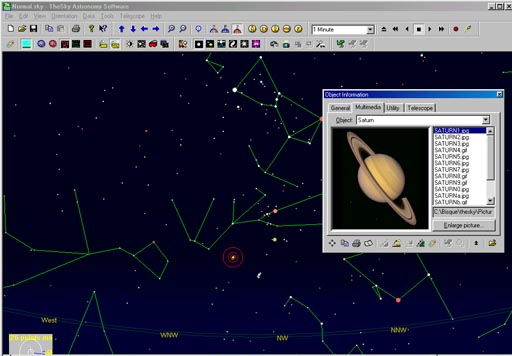 The Sky by
Software
Bisque (a sample screen is seen right) has a comprehensive ensemble of
features and tutorials that help a novice find their way around the sky. The
program is available in various levels and can be used for telescope control
and remote observing programs.
The Sky by
Software
Bisque (a sample screen is seen right) has a comprehensive ensemble of
features and tutorials that help a novice find their way around the sky. The
program is available in various levels and can be used for telescope control
and remote observing programs.
While an clear dark country sky will be a great introduction to naked eye observing, to see more detail you will need a pair or binoculars or an astronomical telescope. Binoculars are difficult to hold steady, so will probably also want to purchase a tripod and binocular tripod adapter. Binoculars are specified by a pair of numbers e.g. 7x30
The first number is the magnification, the second refers to the size of the lenses. For astronomical use we recommend 8x50, 11x70 and 20x80 binoculars.
We often receive calls from customers who are starting out in astronomy, or wish to purchase an inexpensive telescope for a relative or friend.
Seeing as the starting price of most of our telescopes is over $800 (this does not include a mount or eyepieces) we offer the following information to those who are not quite that committed to astronomy yet!
Some common telescope terms:
Aperture: The size of the main lens or mirror that is used in a telescope or binoculars
Apochromat: A telescope that uses very expensive glass or crystal lenses that do not distort the colour of the imageSemi-Apochromat: A telescope that uses special glass to minimize colour distortion of the image
Achromat: A telescope that uses simple lenses that distort the colour of the image
Reflector: A telescope that uses mirrors to from an image
Refractor: A telescope that uses lenses to form an image
SCT: Schmidt Cassegrain Telescope. Uses both a lens and mirror to form an image.
Maksutov: Another telescope that uses both lenses and mirrorsNewtonian: A telescope that uses a primary and secondary mirror to form an image near the aperture end of the telescope
Dobsonian: A large aperture reflecting telescope that uses an inexpensive Alt/Az mount
Equatorial: A telescope & mount that allows it to follow the stars/moon/planets by compensating for the earth's rotation
Alt/Az: A telescope mount that moves up/down and left/right i.e. in altitude and azimuth, that does not easily compensate for the earth's spin.
Magnification: The angular size of an object compared to that seen by the naked eye.
What do you want to do with your telescope?
This is a question that few people rarely ask themselves when starting out in astronomy. If you want to look at boats on the harbour, whales off the shore or fauna at the beach, get a good set of binoculars. Use an Alt/AZ spotting telescope if you need more magnification. Don't forget: with more optical magnification, you will need to support both spotting telescope and binoculars more steadily, as every motion, vibration or bump of your optics will be magnified as well.
To look at the Moon, Planets, Stars, Nebulae, Galaxies etc. you will need an Astronomical telescope. The main job of an Astronomical telescope is to gather light. Forget any claims of department or camera store telescopes of 450x magnification. You need light to view dim objects, and the only thing that will deliver this is aperture.
A good starting point is a 150mm or 6" aperture reflector or a 80mm or 3" refractor. Both of these will deliver reasonably bright views of the stars, moon, planets and brighter nebulae.
A good telescope also needs a sturdy mount, or it will vibrate wildly with every touch. If you want to take pictures through your telescope you will need a motorized equatorial mount, as these compensate for the earth's rotation. Some computer driven Alt/Az mounts will also compensate for the earth's spin, but in a way that is unsuitable for long exposure photography.
There are very few good quality astronomical telescopes available in Australia for a retail price of less that about $1000.
To some extent price can be your guide, but also look at the quality of finish, sturdiness of the mount, supplied accessories and most importantly clarity of the image that the telescope delivers. Though we probably won't be able to help with an introductory telescope, when you want to move up a peg or two, please give us a call.
What can I expect to see through a smaller telescope?
A good quality telescope will show you
|
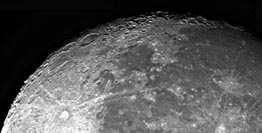 |
|
|
Open Clusters of Stars |
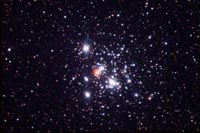 |
Globular Clusters of Stars |
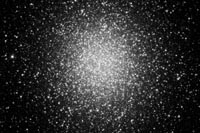 |
Bight Nebulae |
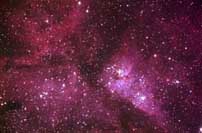 |
Double and Multiple stars |
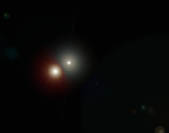 |
A few Galaxies |
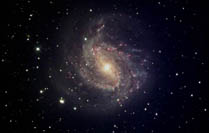 |
Poor quality telescopes often have:
- Cheap, low grade optics (sometimes made of plastic)
- Flimsy tripods
- Chrome plated plastic fittings
- Mild steel screws/plates/fittings (they rust VERY quickly)
- Poor quality 0.96" barrel size eyepieces
- Incredible magnifications (eg 450x) listed on the box. Remember APERTURE counts, not magnification!
How do I know my telescope optics are good? You can read even more about telescope optics here
While there are literally books written on this subject, any telescope can be quickly tested using a method called the "star test". The telescope should pointed at a bright star and be de-focused, then quickly drawn into focus. A good instrument will literally "snap" into a sharp point of light. If the focus seems vague, with no clearly defined point of best focus, you may have a problem. Don't panic yet! This could be caused by atmospheric turbulence (called poor "seeing") or optics that are out of alignment.
The above animation graphically illustrates what "seeing" can do a star's image. With experience you learn to judge the seeing and how it affects your particular telescope's performance
Assuming the seeing is good and the optics are aligned, then you may have a problem. Give your telescope dealer a call, but if you paid $200-$300 at a department or camera store don't expect much expertise in resolving such a problem. Diffraction limited interferometrically tested optics probably costs more to test compared to the entire cost of a $299, 450 power Christmas/Birthday present !
You can generally expect good performance from a 6" aperture or larger Newtonian, Dobsonian, SCT or Maksutov telescopes. Be a little wary of Dobsonians, as their tubes can be made from a type of cardboard and mounts from inexpensive particle-board. Continued exposure to evening dew can see both materials disintegrate in a short time.
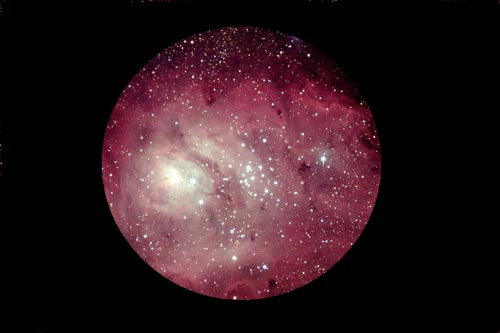 |
Pictured left is the image most novices hope for when the look through a 450X power department or camera store telescope. |
 |
Pictured left: The typical view you will get of a bight nebula through a modest sized telescope. (the image will look like shades of gray due to human vision not being colour sensitive to dim objects) |
So what brand of telescope do we recommend?
The answer lies somewhere between how much interest you have how much you can afford. We do however recommend any SCT from Celestron (or Meade but you'll have to find another dealer) as they are easy to mount well, offer good optics for the price, and are affordable in larger apertures.
We are often asked "Which is better, Meade or Celestron". Again, you could also ask, should I buy a Ford or Toyota? Many people starting out have seen pictures of The Great Nebula in Orion, and want a telescope that can deliver something similar when we look through it.
The reality is something quite different, as looking through a large aperture telescope, colours are barely perceived. With medium to large aperture telescopes the view is often affected by the earth's atmosphere. This is not to say however, a smaller telescope will show more. The larger telescope by virtue of its higher resolving power picks up more detail in the object AND the earth's atmosphere. Thermal currents in the air distort the clarity of the images seen through the telescope eyepiece. As mentioned earlier, seeing can often make an exceptional telescope perform poorly on a night with bad "seeing". (This is why the Hubble space telescope is in space: to get above the earth's atmosphere)
|
|
|
|
The exact same field as imaged on the left, taken with the same telescope and camera, but on a night of good seeing. |
Advanced Telescope Supplies unfortunately does not sell ANY telescope system that priced less than about $700.00 We hope however the information we have supplied here has been of value to help you make an informed purchase decision on an introductory telescope.
Below is a table summarizing the main types of telescope available
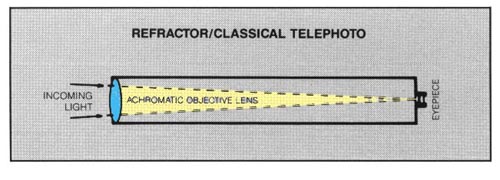 |
The "classical" telescope as used by Galileo.
Cheaper refractors have chromatic or colour error. Large aperture high quality
Apochromatic refractors offer the highest image brightness and contrast
for a given aperture, but are VERY expensive.
Best application: Planetary Observation Quality Brand Names: Willian Optics ,Astro-Physics, Takahashi, Zeiss, Vixen, Borg, Pentax |
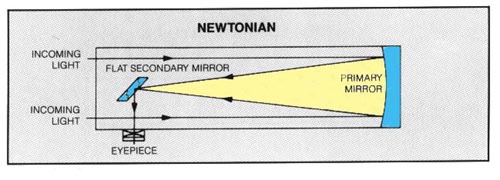 |
Invented by Sir Isaac Newton, this design is free of
chromatic error as seen in the refractor. Off-axis performance is
degraded by Coma, an effect that elongates star images at the edge of
the field. The Newtonian is the most affordable way to obtain a large
aperture telescope optics, but is also difficult to mount well in large
apertures.
Best Application: Deep Sky Observing Quality Brand Names: JMI, Obsession, Celestron |
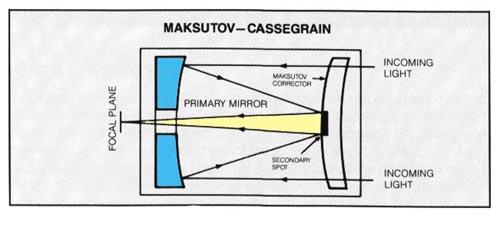 |
A compound telescope system that has few optical design
defects, but typically is only available in long F-Ratios.
Best Application: Planetary Observing. Quality Brand Names: Questar. Meade, Celestron |
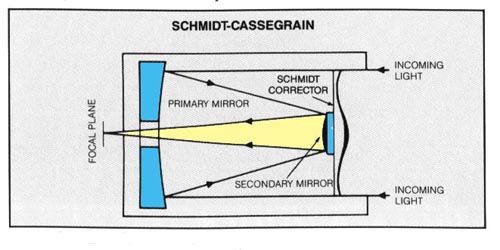 |
A popular compound telescope that has only minor design
defects. Its curved focal plane causes slight distortion of star images
at the edges of photographic and CCD fields.
Best application: General Observing. Quality Brand Names: Celestron, Meade |
Advanced Telescope Supplies can deliver Celestron Schmidt Cassegrain Optics, which provide excellent value for money, and are available in 8", 9.25", 11" and 14" apertures.
We only however, supply Celestron SCT optical tube assemblies (i.e No fork, Nexstar or Ultima mounts).
We can also supply Celestron, William Optics and RCOS with our range of Losmandy & Software Bisque equatorial mountings as a "system", but our main priority is to furnish exacting instruments that will allow you to capture superb visual, photographic and CCD images of the Universe.
All of our telescope systems provide extremely high quality platforms for astrophotography, CCD imaging and for more advanced studies with the main differences from one system to the next being: the aperture of the telescope and size of the mounting required to support it. Below is an example of the results that our customers routinely obtain (Image courtesy C. Willington 2004) using equipment we have recommended.
We also specialize in RC Optical systems Ritchie Chretien telescopes for Professional, Educational and Advanced Amateur applications. Advanced Telescope Supplies do not offer any other telescope optical tubes (eg Questar, Meade, Vixen, Zeiss) for sale, however we recognize these as quality products that will work well on the Losmandy mounting systems that we do offer.
For a tongue and cheek telescope review, go here
Telescope Advertising Myths......(print this page...it will take some digesting!)
You've finally decided to purchase your first telescope. You've probably heard that refractors are better than reflectors, or Celestron is better than Meade or vise versa on all combinations of the former. Making sense of the advertising would probably keep the X-Files Mulder and Scully busy for months. So how do you work out what is right for you and your budget?
Step 1: Be skeptical of glossy two page adverts: read what they really say!
"Largest selling serious telescopes" We've been involved in Astronomy for 35 years, and haven't worked out what a "serious" telescope is, perhaps it's one with a surly attitude. Perhaps it's one with a seriously large price tag or one that can be used for serious research. On that last point, going back a bit further, say 400 years, Galileo pretty much proved a telescope does not have to be big or complex to deliver serious results. But If you really want to get serious we can offer systems up to 1.3 metres in aperture, with dedicated computer control, arc second pointing, fully slaved domed observatory and 35mm sized CCD imaging systems. Don't expect delivery under 2 years or much change from $2,000,000 dollars
"Out-sell competing units three to one" Based on this argument, Toyota or General Motors must make the best cars in the world. Mercedes, Rolls Royce, Lamborghini, BMW, Ferrari and Aston Martin fans will no doubt be disappointed.
"Be Amazed by the Pointing accuracy" Does this mean, be amazed in lots of ways..like where the heck is this thing I'm supposed to be looking at?
"Advanced Ritchie Chretien" This means, not a Ritchie Chretien (RC), but a catadioptric system that is something like a RC, if only in name.
"147,500 object database" Still on the "more is better" line here. The reality is: after the first hundred or so brightest objects, astronomical databases become filled with rather dim, and uninteresting. It's a bit like cataloguing a big ant colony, after you've seen the Queen, nurse maybe some big bull ants, the other 140,000 worker ants all look a bit similar.....and so it is with stars, but let's have a look at them all anyway: say it takes 2 minutes to go from one to the next. Observing for 10 hours every week for the next 10 years should get you to the end of the list, assuming no weather delays..
"1 arc minute High precision pointing mode accuracy " Translation: The standard pointing mode has significant errors which will cause the system to miss the target.
"Designed and Engineered to meet a mounting demand" This one's kind of cute (it was for a new German equatorial mount version of a popular manufacturers telescope line). The copy went on to state "German Equatorial mounts eliminate the tuning fork like vibration associated with fork mounted telescopes"....but, don't these guys also make fork mounted telescopes? They vibrate? Hey! that's our line!...can they really say that?!
Step 2: Understand what the adverts don't say.
Optical Quality: References to "Certified optics" "Exacting standards" "Hand matched" "Hand Figured" and even "Diffraction limited" are vague and say nothing about the aberrations, distortions and smoothness of an optical system. It takes time and money to objectively test a telescope. Some manufacturers, notably RCOS and Astro-Physics interferometrically test each instrument, and have quantitative test data (as below) to prove their performance. Other manufacturer's use a more subjective artificial star test and pass telescopes with an acceptable degree of error. Yet other manufacturers mass produce telescopes and leave it up to the customer to perform the quality check....without giving you the specification manual.
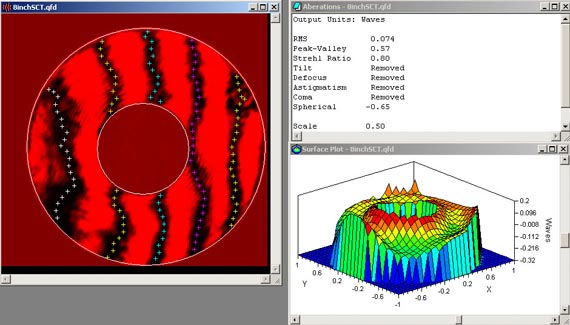 |
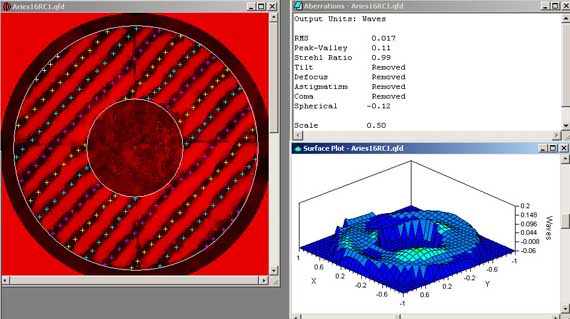 |
| Above is a intererogram of a typical commercial SCT. Inteferograms are NOT to be confused with Ronchi Tests which look similar but are not nearly as accurate. An ideal opitc would have perfectly straight parallel lines. This system has significant spherical error and 1/4 wave optics at best. | Over optical smoothness is calculated from many data points and is inferred from the Strehl ratio. 1/4 wave optics have ratios of 0.8 or 80%. The optic here has a Strehl ratio of 0.99 meaning 99% of the light is being directed into the airy disk, and excellent spherical correction. |
Tracking Accuracy: "Plus or minus 5 arc second tracking error with PEC" This gives no indication of tracking gear smoothness or accuracy. It's a bit like saying I have 20:20 vision with my glasses on, but this gives no indication of how well I can actually see!
Mounting Rigidity: Good hallmarks are a "chunky" look with fully machined components, large bearings, gears and thrust surfaces. Plastic or soft castings small gears, shafts and bushings will almost guarantee your telescope will vibrate wildly when being focused, and literally sway in the breeze.
The Pictures: Those seductive, colour co-ordinated product shots with the galaxy backdrop and all of those wonderful features listed on the side: but wait, there's more! Free steak knives...err, sorry, eyepieces! Sorry folks, but pay for the penny ride and that's what you get. If it sounds too good for the price, it probably is! For example, a plain achromat refractor does not have, as one major manufacturer claims in their advert "a minimum of chromatic aberration"....fact of the matter is, its the only telescope design short of a simple lens that has significant chromatic aberration.
Where do I go from here?
If you've taken the time to read the above, well done! You are probably thinking there are no decent telescopes to be had for less than telephone number price tags :)
Not true! Popular SCT's (read Meade and Celestron) are good value for money, but sometimes the advertising hyperbolae would lead people into thinking they are simply the best there is. They are not, but as P. T. Barnum said "they have a little something for everybody" we can provide custom systems using similar or higher quality optics that, while not cheap, are affordable, but more importantly will work well for years to come.

